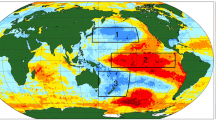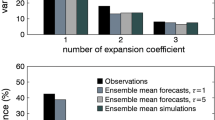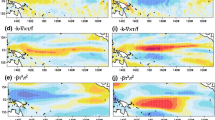Abstract
The “Principal Oscillation Pattern” technique is used to derive an index of the 30- to 60-day oscillation in the tropical troposphere. In the 200-mb equatorial velocity potential field, one dominant pair of POPS is found. Its properties compare very well with the properties of the oscillation identified in previous studies. In particular, a good correlation between the time evolution of the POP coefficients and area-averaged outgoing long-wave radiation (ORL) is found. The POPS are derived from a 2-year subinterval of the whole 5-year data set. This leaves independent data for subsequent verification. The patterns and their characteristic numbers are almost unchanged if the whole data set is analysed. Also, the analysis is insensitive to changes of the analysis area: if the analysis is limited to 90°-longitude equatorial sectors, the signal is also identified and its patterns are consistent with the patterns derived from the full data set. Interestingly, the signal is best defined in the eastern hemisphere. The POPS may be used to derive “associated correlation patterns” of other quantities in winter and summer separately. The path of the oscillation has a marked annual cycle: in northern winter it migrates from the Indian Ocean across northern Australia into the region of the South Pacific Convergence Zone (SPCZ) and in northern summer it moves from the Indian Ocean across South Asia along the intertropical Convergence Zone (ITCZ) to South America. The POP coefficient may be seen as a bivariate index of the state (phase and strength) of the 30- to 60-day oscillation. Since the POP technique incorporates a prediction equation for the phase of the POP coefficients, the POP model allows for the prediction of the complex amplitude of the oscillation. In a sequence of forecast experiments, of which about two-thirds used independent data, the POP forecasts were found to be useful in about half of all cases for lead times of several days. The correlation and RMS skills were calculated for the POP forecast and for persistence. The POP forecast appears to be considerably better with respect to both measures. The correlation skill scores 60% after 7 days. The POP forecast is most skillful in northern winter and if strong signals are present with minima of velocity potential in the eastern hemisphere.
Similar content being viewed by others
References
Hartmann D, Michelsen ML (1989) Intraseasonal perodicities in Indian rainfall. J Atmos Sci 46:2838–2862
Hasselmann K (1988) PIPS and POPs: The reduction of complex dynamical systems using Principal Interaction and Oscillation Patterns. J Geophys Res 93:11015–11021
Huang H-J, Vincent DG (1988) Active and inactive phases of the South Pacific Convergence Zone and changes in global circulation patterns: a case study. Beitr Phys Atmos 61:123–134
Knuson TR, Weickmann KM (1987) 30–60 day atmospheric oscillations: composite life cycles of convection and circulation anomalies. Mon Weather Rev 115:1407–1436
Knutson TR, Weickmann KM, Kutzbach JE (1986) Global-scale intraseasonal oscillations of outgoing longwave radiation and 250 mb zonal wind during Northern Hemisphere summer. Mon Weather Rev 114:605–623
Latif M, Villwock A (1989) Interannual variability in the tropical Pacific as simulated in coupled ocean-atmosphere models. J Marine Systems (in press)
Lau K-M, Chan PH (1985) Aspects of the 40–50 day oscillation during northern winter as inferred from outgoing long wave radiation. Mon Weather Rev 113:1889–1909
Liebmann B, Chelliah M, van den Dool HM (1989) Persistence of outgoing long wave radiation anomalies in the tropics. Mon Weather Rev 117:670–679
Madden RA (1986) Seasonal variations of the 30–60 day oscillation in the tropics. J Atmos Sci 43:3138–3158
Madden RA (1987) Relationships between changes in the length of day and the 40- to 50-day oscillation in the tropics. J Geophys Res 92:8391–8399
Madden RA (1988) Large intraseasonal variations in wind stress over the tropical Pacific. J Geophys Res 93:5333–5340
Madden RA, Julian PR (1972) Description of global-scale circulation cells in the tropics with a 40–50 day period. J Atmos Sci 24:1109–1123
McBride JL (1987) The Australian summer monsoon. In: Chang CP, Krishnamurti TN (eds) Monsoon meteorology. Oxford University Press, pp 203–231
Penland C (1989) Random forcing and forecasting using Principal Oscillation Pattern analysis. Mon Weather Rev 117:2165–2185
Rosen RD, Salstein DA (1983) Variations in atmospheric angular momentum on global and regional scales and the length of day. J Geophys Res 88:5451–5470
Storch H von, Bruns T, Fischer-Bruns I, Hasselmann K (1988) Principal Oscillation Pattern analysis of the 30-to 60-day oscillation in a general circulation model equatorial troposphere. J Geophys Res 93:11022–11036
Storch H von, Weese U, Xu J (1990) Simultaneous analysis of space-time variability: Principal Oscillation Patterns and Principal Interaction Patterns with applications to the Southern Oscillation. Z Meteor 40:99–103
Trenberth KE, Olson JG (1988) Evaluation of NMC global analyses: 1979–1987, NCAR Technical Note NCAR/TN299 + STR
Weickmann KM, Lussky GR, Kutzbach JE (1985) Intraseasonal (30–60 day) fluctuations of outgoing longwave radiation and 250 mb streamfunction during northern winter. Mon Weather Rev 113:943–961
Xu J, Storch H von (1990) “Principal Oscillation Pattern” prediction of the state of ENSO. J Climate (in press)
Author information
Authors and Affiliations
Rights and permissions
About this article
Cite this article
von Storch, H., Xu, J. Principal oscillation pattern analysis of the 30- to 60-day oscillation in the tropical troposphere. Climate Dynamics 4, 175–190 (1990). https://doi.org/10.1007/BF00209520
Received:
Accepted:
Issue Date:
DOI: https://doi.org/10.1007/BF00209520




